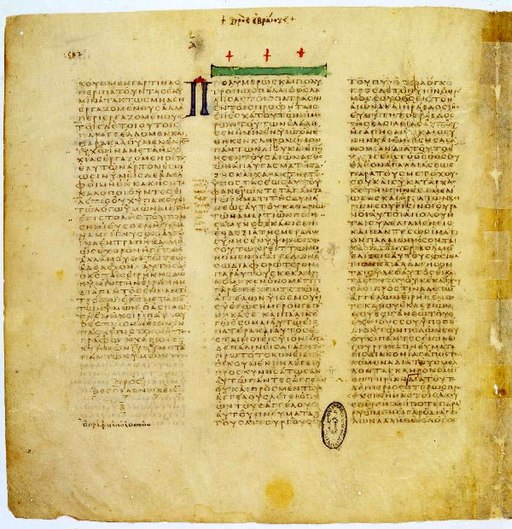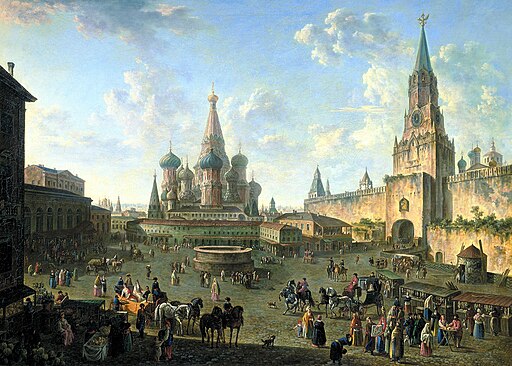The Codex Vaticanus is one of the oldest surviving copies of the Bible and only one of the four surviving codices that containing the entire text of the Greek Old and New Testament Bible.
The Codex is named after the Vatican Library, where it has been kept since at least the 15th century. It is written on 759 leaves of vellum in uncial letters and has been dated to 325–350.
Scholars consider the Codex Vaticanus to be one of the most important witnesses to the Greek text of the New Testament. The most widely sold editions of the Greek New Testament are primarily based on the text of the Codex Vaticanus.
The manuscript is in a quarto volume, composed initially of 830 parchment leaves, but it appears that 71 sheets have been lost.
The parchment is fine and thin. The Codex is written in three columns per page. In the poetical books of the Old Testament, there are only two columns to a page.
The lettering in the Codex is small and neat, without ornamentation or capitals. The Greek is written continuously; all the letters are equidistant from each other; no word is separated from the other; each line appears to be one long word.
There are no enlarged initials, no stops or accents, no divisions into chapters or sections such as are found in later manuscripts.

Page from Codex Vaticanus
The provenance and early history of the Codex are uncertain. Most probably, the book was brought to Rome from Constantinople around the time of the fall of the Byzantine Empire.
The manuscript has been housed in the Vatican Library for as long as it has been known, possibly appearing in the library’s earliest catalog of 1475.
The original writing was re-traced by a later scribe in the 10th or 11th century, and the beauty of the original script was spoiled. Accents and breathing marks, as well as punctuation, have been added by a later hand.
Codex Vaticanus is one of the most important manuscripts for the text of the Greek Old Testament and the Greek New Testament. In 2015, a digitized copy of the Codex was available online from the Vatican Library.
Four Great Uncials
The great uncial codices are the only remaining uncial codices that contain or originally contained the entire text of the Greek Bible.
These handwritten copies of a Christian Bible in Greek, although discovered at different times and places, share many similarities.
They are written in a particular uncial style of calligraphy without regular gaps between words. All these manuscripts were made at great expense of material and labor, written on vellum by professional scribes.
All of the great uncials had the leaves arranged in quarto form:
- Codex Vaticanus – c. 325–350 – Vatican Library
- Codex Sinaiticus – c. 330–360 – discovered in 1844 at St Catherine Monastery in Sinai.
- Codex Alexandrinus – c. 400–440 – British Library – from Alexandria to Constantinople, then given to Charles I of England in the 17th century.
- Codex Ephraemi – c. 450 – Bibliothèque Nationale de France – After the fall of Constantinople in 1453, the Codex was brought to Florence by an émigré scholar. Catherine de’ Medici brought it to France as part of her dowry,
It has been speculated that the first two were part of a project ordered by Emperor Constantine the Great to produce 50 copies of the Bible.

Ending of Luke and Beginning of John in Codex Vaticanus
Vellum
Vellum is prepared animal skin or “membrane,” typically used as a material for writing on. Parchment is another term for this material.
Vellum is prepared for writing to produce single pages, scrolls, or codices and was used for all the great uncial codices.
Vellum is generally smooth and durable, although significant variations are dependent on the preparation and the quality of the skin.
The manufacture involves the cleaning, bleaching, stretching, and scraping of the skin. A final finish may be treating it with lime or chalk to make it accept writing or printing ink.
Modern “paper vellum” is made of synthetic plant material, and is called such for its usage and quality similarities.
Uncial script
Uncial is a script written entirely in capital letters commonly used from the 4th to 8th centuries AD by Latin and Greek scribes. Uncial letters were used to write Greek, Latin, and Gothic.
Early forms are characterized by broad single stroke letters using simple round forms taking advantage of the new parchment and vellum surfaces, as opposed to the angular, multiple-stroke letters, which are more suited for rougher surfaces, such as papyrus.
In the oldest examples of uncial, all of the letters are disconnected from one another, and word separation is typically not used. Word separation, however, is characteristic of later uncial usage.
Uncial was still used, particularly for copies of the Bible, tapering off until around the 10th century. There are over 500 surviving copies of the uncial script.
Codex Vaticanus
- Title: Codex Vaticanus
- Dated: 300–325
- Writing: Greek
- Materials: vellum
- Dimensions: 27 × 27 cm (10.6 × 10.6 in)
- Museum: Vatican Library
THE VATICANUS BIBLE Gospels
Virtual Tour of Famous Maps
- Jacques-Nicolas Bellin Map of the Straits of Malacca
- Abraham Ortelius Map of Southeast Asia
- Meto Navigation Chart
- Stick Chart for Sea Navigation
- Ptolemy’s View of the Solar System
- Piri Reis Map
- Babylonian Map of the World – Imago Mundi
- Ancient and Historical Maps
- Theatrum Orbis Terrarum
- Borgia Map
The Story of Codex Sinaiticus
Virtual Tour of Prehistoric Art and Ancient Artifacts
- Ain Sakhri Lovers
- Wolverine Pendant of Les Eyzies – Prehistoric Portable Art
- Antler Perforated Baton – Paleolithic Portable Art
- Venus of Brassempouy
- Head of a Cycladic Statue, Keros-Syros Culture
- Stargazer – Sculpture of a Female Figure
- Stargazer Figurine
- Dancing Girl (Mohenjo-Daro) from the Indus Valley Civilization
- Prehistoric Stone Hand Axe
- Great Handaxe from Furze Platt
- Clovis Weapons and Tools
- Neolithic Chinese Painted Pottery
- Korean Neolithic Pot
- Neolithic Pottery from Ban Chiang
- Li – Chinese Tripod Jar
- Comb-Pattern Pottery
- Phaistos Disc
- Sican Funerary Mask – Peru
- Greenstone Mask, Central America
- Australian Aboriginal Rock Art – Bradshaw Rock Paintings
- Indigenous Australian Rock Art – Wandjina Style
- Australian Aboriginal Bark Paintings
- Plastered Human Skulls from the Pre-Pottery Neolithic Age
- Neanderthal Flute – Divje Babe Flute
- Prehistoric Deer Skull Headdresses
- Bronze Age Gold Lunula
- Bronze Age Shield Yetholm-type -1200 – 800 BC
The Codex Sinaiticus
Virtual Tour of Important Historical Artifacts
- Prehistoric Stone Hand Axe – 2.6 Million Years Ago
- Perforated Baton with low relief Horse – 40,000 Years Ago
- Venus of Brassempouy – 25,000 years ago
- Wolverine Pendant of Les Eyzies – 12,500 Years Ago
- Ain Sakhri Lovers – 11,000 Years Ago
- Prehistoric Deer Skull Headdress – 11,000 Years Ago
- Narmer Palette – 3,100 BC
- The Stargazer (Statuette of a Woman) – 3000 BC
- Neolithic Painted Pottery – 2,500 BC
- Dancing Girl (Mohenjo-Daro) – 2,500 BC
- Li – Chinese Tripod Jar – 2,300 BC
- Treasure from Troy – 2,200 BC
- Bronze Age Gold Lunula – 2,200 BC
- Gudea, Prince of Lagash – 2,120 BC
- Law Code of Hammurabi – 1,750 BC
- Nebra Sky Disk – 1600 BC
- Mask of Agamemnon – 1,500 BC
- The Sphinx of Hatshepsut – 1,470 BC
- Tutankhamun’s Mask – 1,323 BC
- Mummy of Katebet – 1,300 BC
- Book of the Dead – Papyrus of Ani and Hunefe – 1,250 BC
- Avanton Gold Cone – 1,250 BC
- Bronze Age Shield Yetholm-type -1,200 BC
- Relief of a Winged Genie – 880 BC
- Siloam Inscription – 700 BC
- The Lion Hunt – 640 BC
- Ishtar Gate – 575 BC
- The Curse of the Tabnit Sarcophagus – 500 BC
- Kleroterion – 470 BC
- The Parthenon Marbles – 440 BC
- The Alexander Sarcophagus – 300 BC
- The Winged Victory of Samothrace – 200 BC
- The Rosetta Stone – 196 BC
- The Pergamon Altar – 150 BC
- Antikythera Mechanism – 100 BC
- Battersea Shield – 50 BC
- The Temple of Dendur – 10 A.D.
- James Ossuary – 1st-century
- Lindow Man – 2 BC and 119 AD
Codex Vaticanus – the basis for all modern bible translations
~~~
“I have never looked into the Greek New Testament five minutes without finding something I never saw before.”
– A. T. Robertson
~~~
Photo Credit: 1)Leszek Jańczuk / CC BY-SA (creativecommons.org/licenses/by-sa/4.0)
Popular this Week








 Sponsor your Favorite Page
Sponsor your Favorite Page SEARCH Search for: Search Follow UsJoin – The JOM Membership Program
Sponsor a Masterpiece with YOUR NAME CHOICE for $5
Share this:
- Tweet

